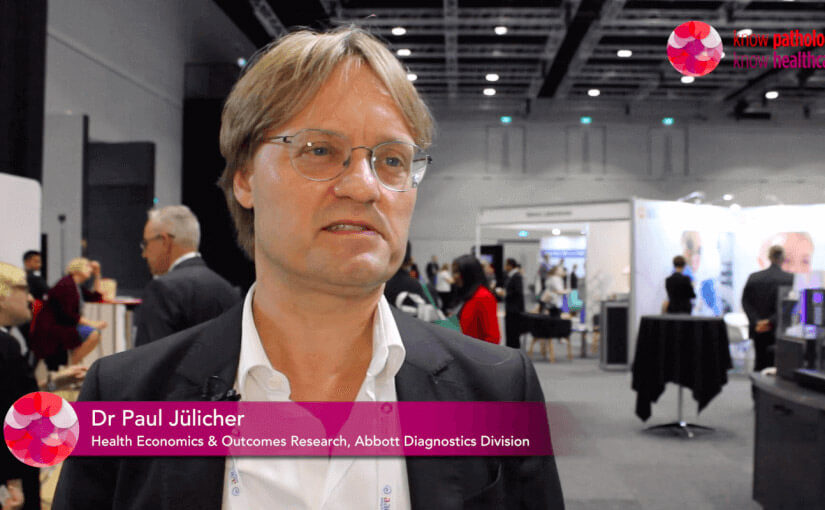In Australia at the start of 2017, an estimated 199,230 people were living with chronic hepatitis C infection, which decreased to 182,144 by the end of that year.
Between the end of 2016 and 2018 more than 20,000 people were cured of hepatitis C thanks to improved access to new treatments during that time.1
So, is hepatitis C history? Not yet.
Currently there is a two-step testing process to diagnose hepatitis C. A patient receives a screening test that detects hepatitis C antibodies in the blood, and if positive will then receive a confirmation pathology test – a polymerase chain reaction (PCR) test.
Unfortunately, after the first positive screening test not all patients return for follow-up. This is a problem because this test only shows that they have had contact with the virus and does not confirm current infection or if treatment is needed.
International expert Dr Paul Jülicher says that streamlining the screening process for hepatitis C by adding extra pathology tests at the start of the diagnostic process could improve the chances of managing the condition.
Dr Jülicher is Director of Health Economics & Outcomes Research at Abbott Diagnostics Division. At the Australian Association of Clinical Biochemists Annual Scientific meeting he presented research conducted on a population screened for hepatitis C in Russia, which showed that there was a 44.8% drop in participation between the two diagnostic test stages, and which subsequently resulted in only 0.2% of people being cured.2
“Data from several countries indicate a huge amount of people get lost along the testing cascade leading to a high number of incomplete diagnoses,” said Dr Jülicher.
Current direct-acting antiviral therapies allow treatment to be completed within 12 weeks. However, this significant investment cannot be utilised unless more people are getting accurately diagnosed and seek treatment.
Dr Jülicher and his team are recommending the use of an antigen test which has been included by the World Health Organisation in a list of essential diagnostics and cited as an acceptable alternative to current testing protocol which has a PCR test.2,3
Streamlining this process with fewer consultations could open the door to improved treatment as global research has found that many people do not proceed to the second test, and are less likely to seek treatment, especially if they are not exhibiting symptoms.
“Hepatitis C is essentially curable, which is why, globally, people are looking to reduce the prevalence so that it is a manageable risk.
“What we have to look into is the cascade of testing and where we lose patients between the tests. We are suggesting a different kind of test, which is an opportunity to reduce the number of steps that are traditionally done before a diagnosis.”
“Here, the test results can show beyond whether it is positive or negative for the antibody, but also whether it is an active infection, for which they can further pursue testing and treatment,” says Dr Jülicher.
When the virus is left untreated, hepatitis C leads to progressive liver damage and cirrhosis, that may leave patients needing highly invasive and expensive liver transplants.
“Australia is definitely one of the leaders in terms of how to eliminate hepatitis C. And while the situation in Australia is not as bad as it is in many other countries, that said, I still think it is an enormous burden,” said Dr Jülicher.
Those at highest risk of hepatitis C infection are people who inject drugs or are subject to other exposures through infected needles and similar equipment. Mothers with chronic hepatitis C also have a small chance of passing on the virus to a baby during pregnancy or childbirth. The virus can also be sexually transmitted under certain circumstances.
“From my understanding, the prevalence in Australia is moderate in the general population, but quite high in high-risk groups such as drug users,” said Dr Jülicher.
“And that is the issue with elimination – you can never eliminate or eradicate a disease if there is a high-risk population that is keeping the virus alive.”
Many people who contract hepatitis C will have no symptoms or only mild symptoms and the virus cannot be detected in initial screening tests until approximately 7-8 weeks after exposure when the immune system has produced antibodies.
Faster diagnosis and access to treatment will also help to stem the spread of the virus.
Kevin Marriott, Acting CEO at Hepatitis Australia says, “while we have a relatively good diagnosis rate in Australia, biomedical technology that can streamline the diagnostic process should be considered.”
“Previously we have considered ways to minimise the lag between the initial antibody testing and the confirmatory PCR testing to ensure the person can access appropriate care as quickly as possible, including the opportunity of being cured. Simplifying testing also has particular benefit in primary care settings where GP’s may be less familiar with the process and are busy with short patient appointments” said Mr Marriott.
References
1 https://kirby.unsw.edu.au/report/hiv-viral-hepatitis-and-sexually-transmissible-infections-australia-annual-surveillance
2 https://journals.plos.org/plosone/article?id=10.1371/journal.pone.0219687#abstract0
3 https://www.who.int/medical_devices/publications/Standalone_document_v8.pdf?ua=1
4 https://apps.who.int/iris/bitstream/handle/10665/254621/9789241549981-eng.pdf;jsessionid=7A22A2DC606372775C63597347C013DB?sequence=1

